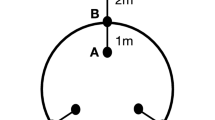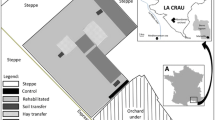Abstract
Soil disturbance is recognised as an important restoration measure for conserving biodiversity in sandy soils. We used a soil disturbance (ploughing) experiment in a sandy grassland as well as a semi-natural disturbance (slope erosion enhanced by cattle trampling) gradient on a sandy slope to test the soil disturbance effects on the ground-living beetle community. Both experimental disturbance and semi-natural disturbance favoured sandy grassland specialists, but there was no overall effect on beetle richness and abundance. Amara lucida and Harpalus spp. were favoured by disturbance while Calathus melanocephalus was disfavoured. Experimental ploughing significantly increased the proportion of red-listed species in disturbed plots compared to non-disturbed controls. In the semi-natural disturbance gradient we found that the beetle community on the disturbed slope differed from that of the flat areas, and there were tendencies for a higher proportion of red-listed species on the slope. We conclude that increasing the area of bare sand in sandy grasslands can have positive effects on many threatened species. Soil disturbance should thus be included as a regular measure in sandy grasslands under conservation management and as a measure to restore high biodiversity in areas where bare sand is rare.


Similar content being viewed by others
References
Andersen J (2000) What is the origin of the carabid beetle fauna of dry, anthropogenic habitats in western Europe? J Biogeogr 27:795–806
Bascompte J, Jordano P (2007) Plant–animal mutualistic networks: the architecture of biodiversity. Annu Rev Ecol Syst 38:567–593
Bertoncelj I, Dolman PA (2013) Conservation potential for heathland carabid beetle fauna of linear trackways within a plantation forest. Insect Conserv Divers 6:300–308
Cizek L, Hauck D, Pokluda P (2012) Contrasting needs of grassland dwellers: habitat preferences of endangered steppe beetles (Coleoptera). J Insect Cons 16:281–293
Dahlström A, Cousins SAO, Eriksson O (2006) The history (1620–2003) of land use, people and livestock, and the relationship to present plant species diversity in a rural landscape in Sweden. Environ Hist Camb 12:191–212
Desender K, Bosmans R (1998) Ground beetles (Coleoptera, Carabidae) on set-aside fields in the Campine region and their importance for nature conservation in Flanders (Belgium). Biodiv Cons 7:1485–1493
Gärdenfors U (ed) (2010) The 2010 Red List of Swedish species. ArtDatabanken, SLU, Uppsala
Gazenbeek A (2005) LIFE, Natura 2000 and the military. LIFE focus, European Commission
Hansen V (1927) Biller VII, Bladbiller og bønnebiller (Chrysomelidae & Laridae). Danmarks Fauna 31, Copenhagen, Denmark
Hobbs RJ, Huenneke LF (1992) Disturbance diversity and invasion implications for conservation. Cons Biol 6:324–337
Irmler U, Hoernes U (2003) Assignment and evaluation of ground beetle (Coleoptera: Carabidae) assemblages to sites on different scales in a grassland landscape. Biodiv Cons 12:1405–1419
Jentsch A, Friedrich S, Steinlein T, Beyschlag W, Nezadal W (2009) Assessing conservation action for substitution of missing dynamics on former military training areas in Central Europe. Rest Ecol 17:107–116
Johansson LJ, Hall K, Prentice H, Ihse M, Reitalu T, Sykes M, Kindström M (2008) Semi-natural grassland continuity, long-term land-use changes and plant species richness in an agricultural landscape on Öland, Sweden. Landsc Urban Plan 84:200–211
Knisley CB (2011) Anthropogenic disturbances and rare tiger beetle habitats: benefits, risks, and implications for conservation. Terr Arthropod Rev 4:41–61
Knisley CB, Arnold RA (2004) Biology and conservation of the Ohlone tiger beetle, Cicindela ohlone. Final report to U. S. Fish and Wildlife Service, Ventura, California, USA. pp 34
Landin BO (1957) Svensk insektsfauna 9: Skalbaggar, Bladhorningar: fam. Scarabaeidae. Entomologiska föreningen, Stockholm, Sweden
Lin Y-C, James R, Dolman PM (2007) Conservation of heathland ground beetles (Coleoptera, Carabidae): the value of lowland coniferous plantations. Biodiv Cons 16:1337–1358
Lindroth CH (1961) Svensk insektfauna. 9, Skalbaggar, Coleopetra, Sandjägare och jordlöpare, fam. Carabidae, 2nd ed. Entomologiska föreningen, Stockholm, Sweden
Lindroth CH (1967) Våra skalbaggar och hur man känner igen dem, del III. Bonniers, Stockholm
Ljungberg H (2002) Important habitats for red-listed ground beetles in Sweden. Entomologisk Tidskrift 123:167–185
Ljungberg H (2005a) Artfaktablad: Harpalus anxius, smal frölöpare. Artdatabanken SLU, Uppsala
Ljungberg H (2005b) Artfaktablad: Harpalus neglectus, dynfrölöpare. Artdatabanken SLU, Uppsala
Ljungberg H (2005c) Artfaktablad: Harpalus melancholicus, dysterlöpare. Artdatabanken SLU, Uppsala
Lönnell N, Ljungberg K (2006) Sandtäkter – en miljö att slå vakt om. Fauna Flora 101:38–43
Luff ML (2007) The Carabidae (ground beetles) of Britain and Ireland. Royal Entomological Society, St. Albans
Niemelä J (2001) Carabid beetles (Coleoptera: Carabidae) and habitat fragmentation: a review. Eur J Entomol 98:127–132
Niemelä J, Baur B (1998) Threatened species in a vanishing habitat: plants and invertebrates in calcareous grasslands in the Swiss Jura mountains. Biodiv Cons 7:1407–1416
Nijssen M, Alders K, van der Smissen N, Esselink H (2001) Effects of grass-encroachment and grazing management on carabid assemblages of dry dune grasslands. Proc Exp Appl Entomol NEV Amst 12:113–120
Noordijka J, Schaffers AP, Heijermanb T, Sykoraa KV (2011) Using movement and habitat corridors to improve the connectivity for heathland carabid beetles. J Nat Cons 19:276–284
Öckinger E, Eriksson AK, Smith HG (2006) Effects of grassland abondonment, restoration and management on butterflies and vascular plants. Biol Cons 133:291–300
Ödman AM, Olsson PA (2014) Conservation of sandy calcareous grassland: What can be learned from the land use history? PLoS One 9(3):e90998
Ödman AM, Mårtensson L-M, Sjöholm C, Olsson PA (2011) Immediate responses in soil chemistry, vegetation and ground beetles to soil perturbation when implemented as a restoration measure in decalcified sandy grassland. Biodiv Cons 20:3039–3058
Ödman AM, Schnoor TK, Ripa J, Olsson PA (2012) Soil disturbance as a restoration measure in dry sandy grasslands. Biodiv Cons 21:1921–1935
Olsson PA, Ödman AM (2014) Natural establishment of specialist plant species after topsoil removal and soil perturbation in degenerated calcareous sandy grassland. Rest Ecol 22:49–56
Perner J, Malt S (2003) Assessment of changing agricultural land use: response of vegetation, ground-dwelling spiders and beetles to the conversion of arable land into grassland. Agric Ecosyst Environ 98:169–181
Rainio J, Niemelä J (2003) Ground beetles (Coleoptera: Carabidae) as bioindicators. Biodiv Cons 12:487–506
Řehounková K, Prach K (2008) Spontaneous vegetation succession in gravel–sand pits: a potential for restoration. Rest Ecol 16:305–312
Schnoor TK, Olsson PA (2010) Effects of soil disturbance on plant diversity of calcareous grasslands. Agric Ecosyst Environ 139:714–719
Turin H, Den Boer PJ (1988) Changes in the distribution of carabid beetles in the Netherlands since 1880. II. Isolation of habitats and long-term time trends in the occurrence of carabid species with different powers of dispersal (Coleoptera, Carabidae). Biol Cons 44:179–200
Van Swaay CAM (2002) The importance of calcareous grasslands for butterflies in Europe. Biol Cons 104:315–318
Vermeulen HJW (1993) The composition of the carabid fauna on poor sandy road-side verges in relation to comparable open areas. Biodiv Cons 2:331–350
WallisDeVries MF, Poschlod P, Willems JH (2002) Challenges for the conservation of calcareous grasslands in northwestern Europe: integrating the requirements of flora and fauna. Biol Cons 104:265–273
Warren SD, Büttner R (2008) Active military training areas as refugia for disturbance-dependent endangered insects. J Insect Cons 12:671–676
Warren SD, Holbrook SW, Dale DA, Whelan NL, Elyn M, Grimm W, Jentsch A (2007) Biodiversity and the heterogeneous disturbance regime on military training lands. Rest Ecol 15:606–612
Wassen MJ, Venterink HO, Lapshina ED, Tanneberger F (2005) Endangered plants persist under phosphorus limitation. Nature 437:547–550
Widgren Å (2005) Häljarums naturreservat – ett grustag med rara växter. Svensk Botanisk Tidskrift 99:265–268
Acknowledgments
We gratefully acknowledge financial support from the County Administrative Board in Skåne and The Swedish Research Council.
Author information
Authors and Affiliations
Corresponding author
Rights and permissions
About this article
Cite this article
Olsson, P.A., Sjöholm, C. & Ödman, A.M. Soil disturbance favours threatened beetle species in sandy grasslands. J Insect Conserv 18, 827–835 (2014). https://doi.org/10.1007/s10841-014-9689-6
Received:
Accepted:
Published:
Issue Date:
DOI: https://doi.org/10.1007/s10841-014-9689-6




